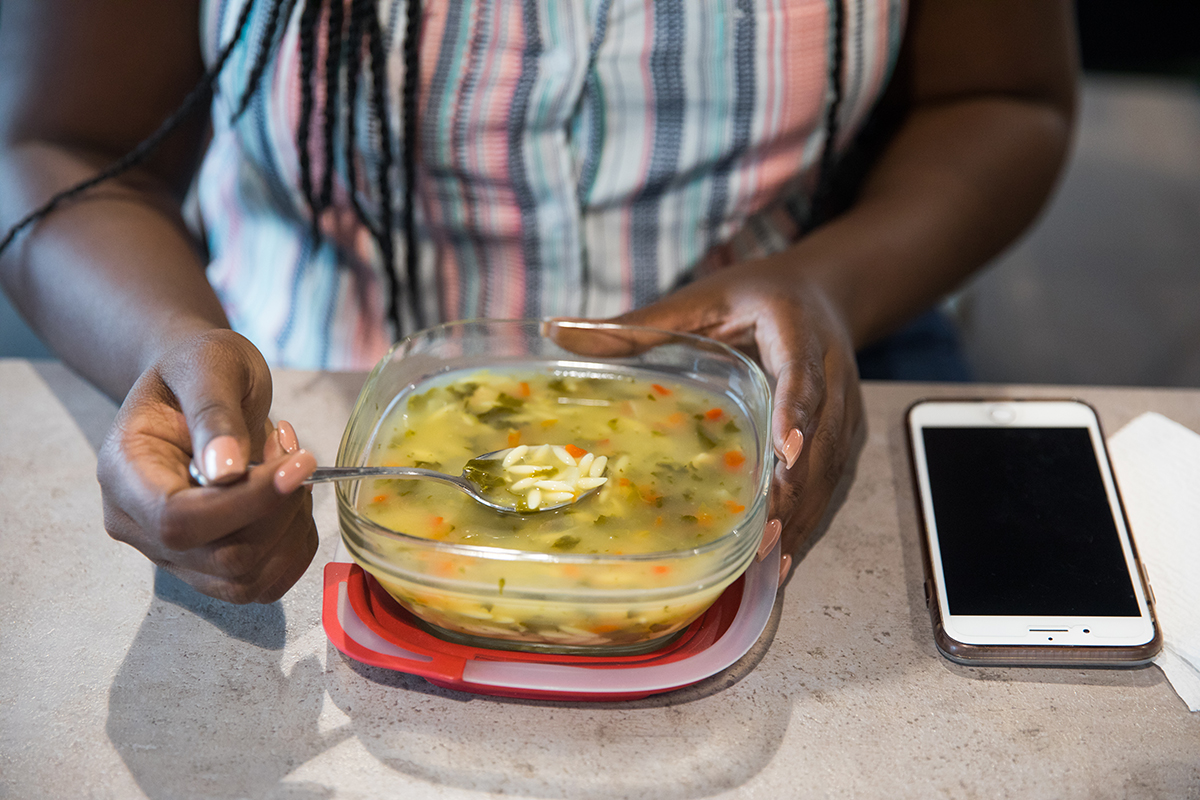I Want to Pay Off $30K of Student Loans in 3 Years. Here’s How I’m Doing

Working at The Penny Hoarder, I get a front-row seat to my co-workers’ stories of paying off tens of thousands of dollars in debt at lightning-fast speeds.
I hear stories about co-workers who save more than $10,000 in a single year. I hear about their frugal habits that save them thousands of dollars that they plan to put toward early retirement, their sky-high credit scores and the cars they buy with cash.
Sometimes, those stories are the boost I need to make an extra $500 payment toward my student loan debt that month. Other times, it’s a little intimidating to think about how long I have to go before I reach their levels of financial freedom.
Earlier this year, I set a goal: I wanted to pay down my debt. All of it — a few hundred on credit cards and more than $30,000 in student loans. And I set out to do it in less than three years.
It’s awesome when you get to read the success stories at the end of the process, but here’s a look into what it’s really like when you make such a grand goal and you’re figuring out how to get started.
How I Paid Off $3,632 in the First 3 Months

Before I could tackle my debt, I needed to evaluate my financial standing.
I started with my credit cards for an easy win. I only carried a balance on one card, and it was just a few hundred dollars.
So I paid off the last $506 of credit card debt in March, and I was done.
The following month, I used my momentum to start tackling the real beast: my student loan debt. I was determined to put every extra cent that came in toward it. Two performance bonuses at work. My tax return. Mileage reimbursement from a business trip.
From April to June, I paid down $2,426.44.
Everything was going great. Then, I had my first setback.
One of my credit cards gives me 1% cash back when I spend — and again when I pay my bill. With a $0 balance, I wanted to cash in on the rewards.
My plan was simple: Buy things with my credit card and pay it off once a week. Since I didn’t plan to carry a balance, the cash back would be like free money. After just a few months of debt repayment, I was convinced I had turned over a new, more disciplined financial leaf.
Spoiler alert: I didn’t.
Within two months, I had a $700 balance. That meant money that was supposed to pay off my student loans paid off the card — again.
Sometimes, I’m able to keep my credit card debt at $0; other times, I’m not. But this was the first lesson I learned from the process: Being debt-free is a journey, not a destination.
My new goal isn’t just about having zero credit card debt at any given point. Instead, it’s to learn to use my credit cards responsibly. For me, that means paying them off each month so I never have to pay interest. And if I do have a balance that carries over from month to month, I attempt to keep it as low as possible.
If you’re keeping up with my math, that means I paid off $3,632.44 of debt in just a few months.
For most people, that might feel great. But for me, knowing I still have $31,958.92 left on my student loans makes it tough to be too excited.
Knowing how much I have paid toward debt only reminds me of all the clothing in my closet that still has tags, the shoes I never wear, and the groceries I buy and then throw out because they go bad faster than I can eat them.
All of that stands between me and the goal to pay off my student loans. I decided I needed a way to get a handle on my spending so I could track how much I should be putting toward my debt to meet my goal.
How I’m Reining in My Spending Habits

If the ratio of my credit card debt to student loan debt is any indication, I was already pretty good at living within my means before I took on this challenge.
The bright side of that is that I’ve purposefully designed my life so that all my bills can be paid with a single paycheck. That includes my rent, my car note and car insurance, utilities — everything.
The downside is that I also tend to think that if there’s enough money in my bank account to buy something I want on a given day, that means I can afford it.
So while I don’t spend more than I have on hand, I also don’t tend to consider when future bills are due or that the money could go toward savings and debt instead of whatever I can fit into a Target handbasket.
The first three months of this process were easy because all the debt payments were made with extra money that I brought in above my normal salary.
The real work started once all that extra income had been exhausted.
This meant going through the difficult process of analyzing my spending to break some bad habits that honestly, until now, didn’t even seem that bad.
One of the more helpful things I did was track my spending.
I’ve used the Mint app to automatically track my spending in the past, but it never actually stopped me from spending money; it only made me feel guilty until I eventually turned the notifications off.
Then in June, I took a 21-day email course with the Consumer Financial Protection Bureau that was surprisingly useful.
Over the span of three weeks, I had to write down every bill I had on a calendar, list all my sources of income and track every time I spent any money. The point was to start bringing my spending habits to the front of my mind and start prioritizing how I was going to pay down debt and still enjoy my life.
I won’t lie. This is still a challenge for me. A big one. So big that it could be the one that derails this whole process for me.
Tracking my spending can put a lot of pressure on me to spend absolutely nothing, but I want to enjoy these next three years. So even as I learn more about my spending and break some deep-seated habits, there are still some things I don’t plan to give up.
How I’m Balancing Bills, Debt Payments and Having a Life

In a perfect world, paying off another loan would be all I needed to do to have a good time. I wish that was the world I lived in. Unfortunately, almost everything I like costs money.
There are some things I don’t mind giving up. For example, my biggest expense after my rent and car note was food.
I would buy groceries every week and then, because I was too lazy to cook, eat out nearly every day anyway. That meant I was wasting on both ends. My groceries would go bad, and the expensive restaurant meals would add up quickly.
After months of trying to curb that habit, I’m finally at the point of eating out less and actually cooking the groceries I have on hand. Some weeks, I don’t eat out at all. That — from the girl who, at her worst, ordered Uber Eats twice a day for days on end — is a big deal.
I also fell into the habit of driving to work to avoid the Florida summer heat. But driving four times a week only saved four blocks of walking per day and cost me $7 a day to park.
This summer, I’m challenging myself to skip driving and ride my bike or walk instead to limit transportation costs.
I have also been participating in occasional “no-spend weeks.” That’s when I go seven days at a time without spending any money at all. This hasn’t helped me pay down my debt any faster, but it has helped me be conscious of my spending habits and determine what I do and don’t need in a given week.
In the future, I’m hoping to plan my no-spend weeks so that they follow large student loan payments.
Making so many small changes has also helped to justify other expenses. For example, I like to get my nails done. It’s a little vain and a bit pricy. But I love it. No amount of student loan debt is going to guilt me into canceling my biweekly appointments.
How I’m Staying Motivated When I Still Have Years to Go

Most of the changes I’ve made are pretty minor.
It’s not such a big deal to cut back on dining out for a few months. Or to do a no-spend week every now and then. Or even to ride my bike to work for a summer.
But I know that if I’m going to pay down this debt in the next three years, these can’t just be small changes for a few months. These have to be lifestyle changes that last at least a few years, if not a lifetime.
That’s what makes this goal hard and what makes staying motivated so difficult.
What has worked best for me so far is talking about it.
I complain incessantly to my friends. I talk about it to co-workers who have already done it. I write stories like this. I stop and do the math, and then pat myself on the back for the progress I’m making. I put a note on my desk to remind myself of how much I’ve already paid down.
I keep it in the front of my mind all the time.
I also try to stay realistic. I made my three-year goal based on where I was financially when I set the goal.
Over the next three years, good news like promotions and raises may speed things up, and not-so-great things like an unexpected car repair might set me back a few months. I’m leaving room to be flexible with myself, because whether it takes me three years or five, I’ll still be debt-free.
Desiree Stennett is a former staff writer at The Penny Hoarder.



















